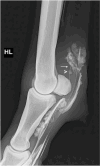Does Low-Field MRI Tenography Improve the Detection of Naturally Occurring Manica Flexoria Tears in Horses?
- PMID: 40805040
- PMCID: PMC12345494
- DOI: 10.3390/ani15152250
Does Low-Field MRI Tenography Improve the Detection of Naturally Occurring Manica Flexoria Tears in Horses?
Abstract
Diagnosing digital flexor tendon sheath (DFTS) pathologies, particularly manica flexoria (MF) tears, can be challenging with standard imaging modalities. Standing low-field MRI tenography (MRIt) may improve the detection rate of MF tears. This study aimed to compare ultrasonography, contrast radiography, pre-contrast MRI, and MRIt to detect naturally occurring MF lesions in horses undergoing tenoscopy. Ten horses with a positive DFTS block, which underwent contrast radiography, ultrasonography, MRI, MRIt, and tenoscopy were included. Two radiologists evaluated the images and recorded whether an MF lesion was present and determined the lesion side. Sensitivity and specificity were calculated for each modality using tenoscopy as a reference. MRIt and contrast radiography detected MF lesions with the same frequency, both showing 71% sensitivity and 100% specificity. Pre-contrast MRI and ultrasonography detected MF lesions with a lower sensitivity (57%); however, the MRI (100%) demonstrated a higher specificity than ultrasonography (33%). Adding contrast in MRI changed the sensitivity from (4/7 lesions) 57% to (5/7 lesions) 71%, with a constant high specificity (100%). MRIt diagnoses MF tears with a similar sensitivity to contrast radiography, with the same specificity, but with the added benefit of lesion laterality detection. The combined advantages of the anatomical detail of the T1 sequence and the post-contrast hyperintense appearance of the fluid may help diagnose MF tears and identify intact MFs. However, this needs to be substantiated in a larger number of cases.
Keywords: MRI; horse; manica flexoria; tenoscopy.
Conflict of interest statement
The authors have no personal interests to declare.
Figures




Similar articles
-
Equine non-septic tenosynovitis: A systematic literature review of site-specific pathological lesions, outcomes and surgical complications.Equine Vet J. 2024 Sep;56(5):842-857. doi: 10.1111/evj.14000. Epub 2023 Sep 21. Equine Vet J. 2024. PMID: 37735927
-
Does Direct MRI Tenography Improve the Diagnostic Performance of Low-Field MRI to Identify Artificially Created Soft-Tissue Lesions within the Equine Cadaveric Digital Flexor Tendon Sheath?Animals (Basel). 2023 Dec 7;13(24):3772. doi: 10.3390/ani13243772. Animals (Basel). 2023. PMID: 38136809 Free PMC article.
-
Normal MRI features of the manica flexoria in horses and evaluation of the anatomic variability between forelimbs and hindlimbs.PLoS One. 2025 Jul 21;20(7):e0327880. doi: 10.1371/journal.pone.0327880. eCollection 2025. PLoS One. 2025. PMID: 40690480 Free PMC article.
-
Contrast-enhanced ultrasound using SonoVue® (sulphur hexafluoride microbubbles) compared with contrast-enhanced computed tomography and contrast-enhanced magnetic resonance imaging for the characterisation of focal liver lesions and detection of liver metastases: a systematic review and cost-effectiveness analysis.Health Technol Assess. 2013 Apr;17(16):1-243. doi: 10.3310/hta17160. Health Technol Assess. 2013. PMID: 23611316 Free PMC article.
-
Imaging modalities for the non-invasive diagnosis of endometriosis.Cochrane Database Syst Rev. 2016 Feb 26;2(2):CD009591. doi: 10.1002/14651858.CD009591.pub2. Cochrane Database Syst Rev. 2016. PMID: 26919512 Free PMC article.
References
-
- Arensburg L., Wilderjans H., Simon O., Dewulf J., Boussauw B. Nonseptic tenosynovitis of the digital flexor tendon sheath caused by longitudinal tears in the digital flexor tendons: A retrospective study of 135 tenoscopic procedures. Equine Vet. J. 2011;43:660–668. doi: 10.1111/j.2042-3306.2010.00341.x. - DOI - PubMed
-
- Wilderjans H., Boussau B., Madder K., Simon O. Tenosynovitis of the digital flexor tendon sheath and annular ligament constriction syndrome caused by longitudinal tears in the deep digital flexor tendon: A clinical and surgical report of 17 cases in Warmblood horses. Equine Vet. J. 2003;35:270–275. doi: 10.2746/042516403776148183. - DOI - PubMed
LinkOut - more resources
Full Text Sources

